Moving across the world is stressful. You have to sort out your own logistics, flights, where you’re going to live, and what jobs you’re going to apply for. In this detailed guide, I’m going to teach you how to bring your pet from South Korea to the USA.
As your internet big sister, I just gotta say one thing… I better not catch you leaving your fur baby behind! “I’ll cash you outside. How about dat?” I adopted my best friend in Korea and knew I was bringing her back to the States
If you’re looking into how to bring your dog from South Korea to the USA or how to bring your cat to the USA, then this guide is everything pet owners need to know when relocating.
*Note: This blog post is updated every year. As of 2024, this is the most accurate post on importing domestic dogs and cats into the United States.*
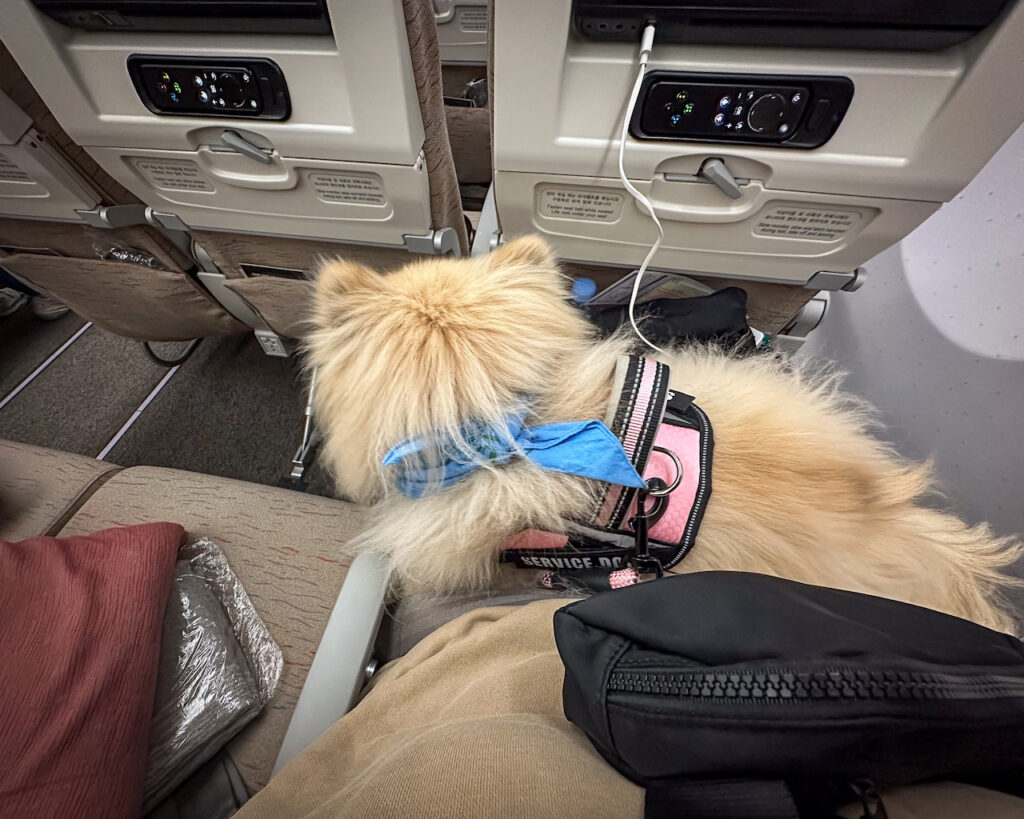
Blog Posts You Might Like
- How To Adopt A Dog in South Korea
- How To Bring Your Pet From the USA to South Korea
- How To Travel With a Dog By Plane
Your Pet’s Paperwork
Be very thorough completing your pet’s paperwork. You wouldn’t want your furry friend thrown quarantine upon arrival.
- Microchip (optional)
- Proof of rabies vaccination
- Valid health certificate
Microchip (Optional)
A microchip implant is not a requirement for dogs or cats. However, if your bestie gets lost, you’ll have a higher chance of having them returned to you. When microchipping, I recommend getting the international 15 digit microchip number that meets ISO standards is 11784/11785.
This iso-compliant microchip guarantees you won’t have to microchip your pet again if you choose to leave again for a foreign country.
I personally microchipped Honey when I returned back to the United States. She uses the Home Again service which has all my updated information and emergency contacts should we ever be separated.
Your local Korean vet should be able to provide and ISO standard chip. If they don’t have one, they can order one for you. It costs about 50,000KRW to microchip your pet.
Using a slightly larger needle, the microchip is inserted under the skin between the shoulder blades. Your vet will then scan the chip to make sure it works and provide you with documentation.
Rabies Vaccination
The United States Center For Disease Control requires a current rabies vaccination. The rabies vaccine should be administered no less than 30 days before your flight and no more than a year before. Your local veterinarian should fill out the form for the valid rabies vaccination certificate.
DOWNLOAD THE RABIES CERTIFICATE HERE
IIf you have a cat, the process is much easier. The U.S. doesn’t require proof for a cat rabies vaccination. However, some states will require your cat to be vaccinated.
Cats being imported into the state of Hawaii and the territory of Guam are subject to a quarantine period. It is about 30-120 days of quarantine depending on the situation. For more information, check here.
Animal Health Certificate
No more than 10 days before your departure your licensed veterinarian should complete the animal health certificate. This certifies your pet is healthy and safe for travel.
DOWNLOAD THE ANIMAL HEALTH CERTIFICATE HERE
Animal and Plant Quarantine Agency
You must bring the rabies vaccination certificate, animal health certificate, and your pet to the Animal Plant and Quarantine Agency. At the Animal Plant Health Inspection Service, you receive an import permit.
It states your pet has been inspected by the Republic of Korea and they are free to import into the United States of America. The fee is 10,000 won.
IMPORTANT: The Animal and Plant Quarantine Agency will give you two copies of that certificate. They will give you an original and a copy. Do not let the staff at the airport counter take the original copy. Give them the copy or ask to make a copy of your copy.

Local Plant and Animal Quarantine Office
Pro Tip: If your flight leaves earlier than 9am, then it’s best to stop by your local Plant and Animal Quarantine Office. On the form, you will see the government agency of the exporting country completed by a competent authority of the exporting country.
You do not need a reservation and can just walk in. For a list of all the Animal and Plant Quarantine Offices in Korea, click here.
Address: RM#171, Gimpo International Airport, 38 Haneul-gil, Gangseo-gu, Seoul, Republic of Korea

Plant and Animal Quarantine Office at Incheon Airport
If you choose to take your pet to the Plant and Animal Quarantine Office at Incheon Airport, then you will take your pet, the rabies vaccination certificate, and international health certificate to Incheon Airport. Below are maps, locations, and operating times of the offices in Terminal 1 and Terminal 2.
Arrive at the airport at least 2 hours earlier than you normally would so you can get the paperwork done in time. The staff will check your forms, the animal, and ask a few questions. Then, they will then issue you the official document with a seal that costs 10,000 won.

| Operating Hours | 9am - 6pm |
| Contact | 032) 740-2660 |
| Location | Floor 3, inside Exit 7 |
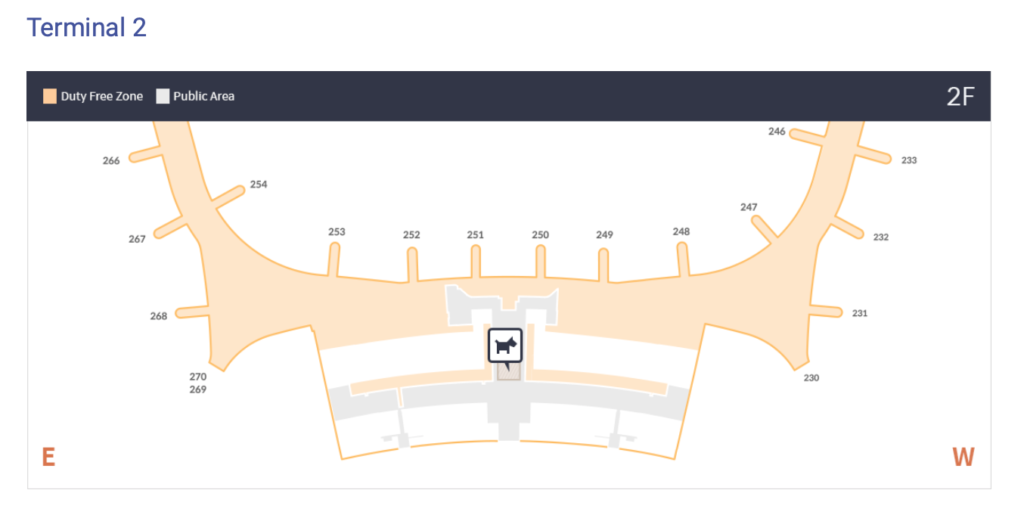
| Operating Hours | 9am - 6pm |
| Contact | 032) 740-2028 |
| Location | Passenger Terminal 2 Public-accessible Area |
Pet Airline Reservation
As of December 2, 2020, the U.S. Department of Transportation announced its final ruling that Emotional Support Animals are no longer considered service animals. If your pet is an ESA, then at the owner’s expense you will be charged an in-cabin pet fee.
Flying In-Cabin With Your Service Animal
For a complete post on How To Bring Your Pet From the USA to South Korea, click here. I have trained Honey as my service animal. Before I brought her to Korea, I was required to bring a rabies antibody titer test. It had to have been done by an internationally approved laboratory.
When flying back, bring the rabies-neutralization antibody test (as it really helps speed up the process in the quarantine office) along with the rabies certificate, and health certificate.
Additional requirements are for you to bring a Department of Transportation (DOT) form. If you forgot, you can fill one out at the airport like I did with United Airlines. You will also need to bring documentation of proof of your animal as a trained service animal.
I was able to get access to priority lines and pre-boarding to stow my things swiftly.
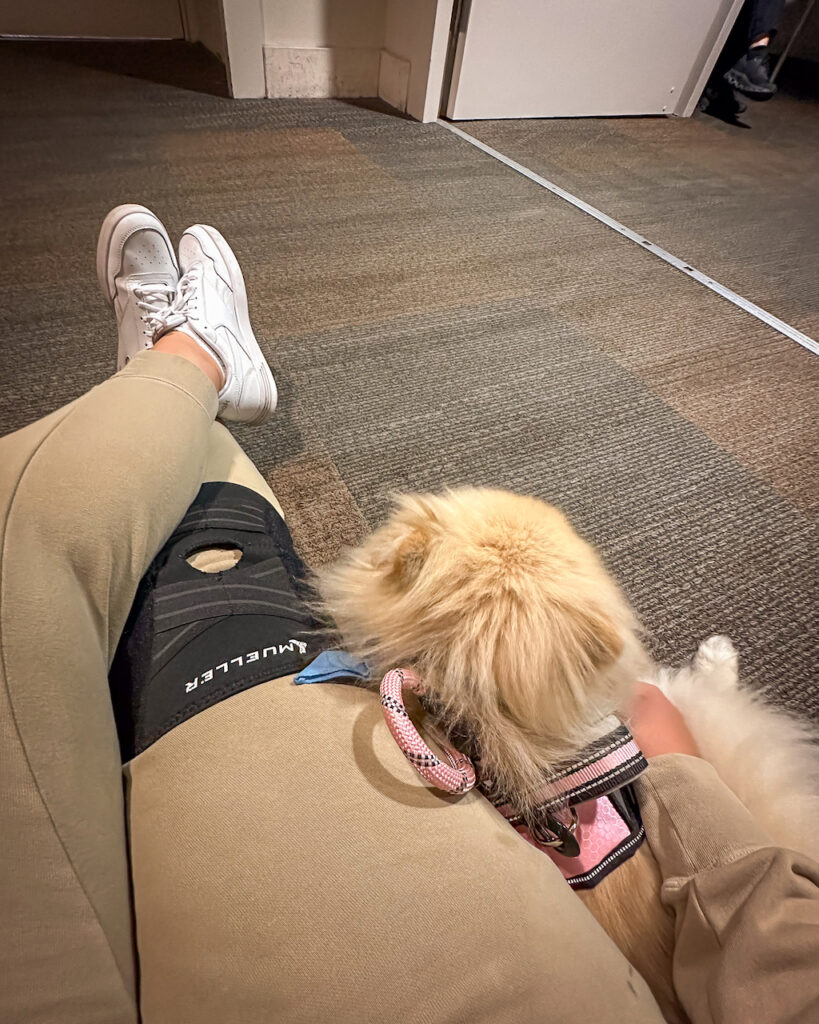
Flying In-Cabin With Your Pet
f your pet is the appropriate size for the airline’s weight and size restriction, you can carry your pet in-cabin. This means your fur baby can accompany you on the plane.
Most airlines will require you make a reservation. In addition, your pet must remain in the carrier under the seat at all times. Every airline has different requirements. Here is the list of airlines that allow you to carry pets on board.
These are the only airlines from Korea that allow pet travel in-cabin. If your airline is not on the list, then don’t book it for a smoother flight experience and transition. Be sure to double check Delta because there are destination specific restrictions and regulations.
In-Cabin Pet Travel Cost
- Asiana Airlines – 32kg or less ($290 or 290,000KRW)
- Delta Airlines – $200
- Korean Air – 32kg or less ($300 or 300,000KRW)
- United Airlines – $150
- Air Canada – $100
Pet Weight Restrictions
The rules vary by airline, but just so you know, Korean Air and Asiana follow their rules to the letter. You will be advised if you have to pay extra to transport your pet as cargo. These restrictions are based on the weight of your pet plus the carrier.
- Korean Air & Asiana – 7kg (15 pounds)
- United, Delta, and Air Canada – no weight limit
Pet Carrier Restrictions
Every airline has different pet carrier restrictions. The airline staff will check if your pet fits comfortably. If your carrier isn’t the right size, your pet is uncomfortable, or too big to fit under the seat, then you will be asked to purchase a different carrier from the airline at the desk. It’s also possible you can be turned away and refused pet boarding.
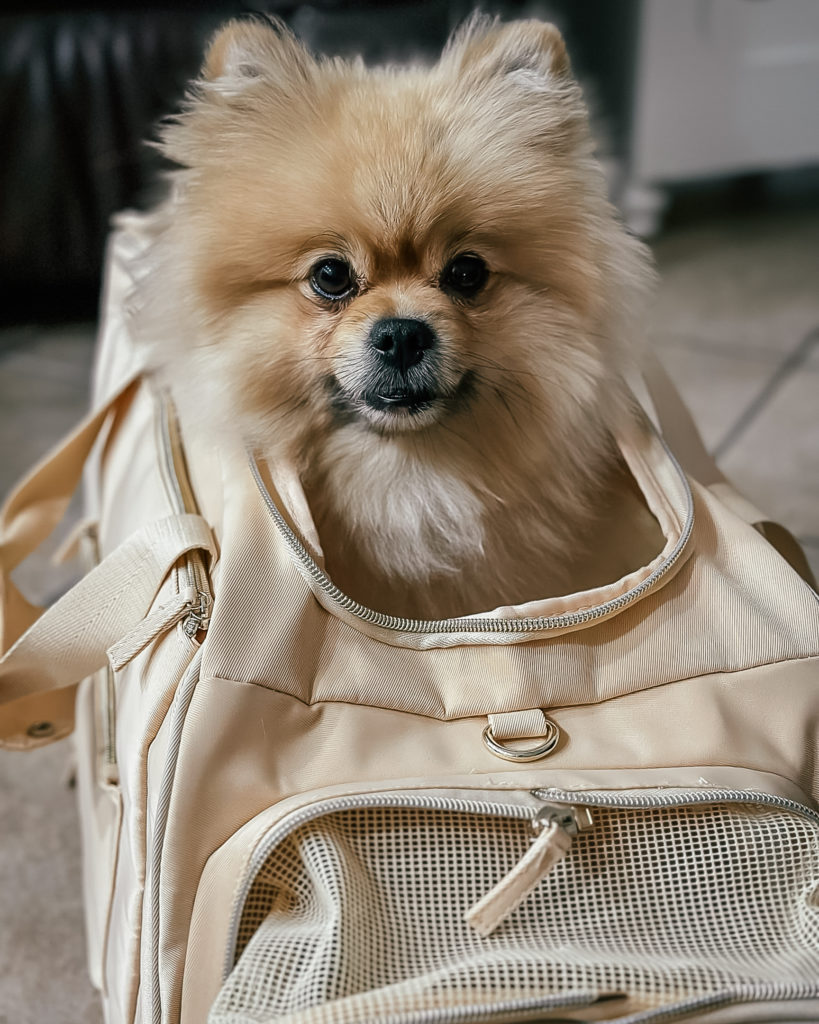
Most Airlines Require:
- Your pet must fit comfortably in their carrier.
- The kennel must fit directly under the seat in front of you.
- Both soft and hard kennels must be leak proof and have ventilation openings on three sides. (Or four sides for international travel.)
- Your pet must remain inside the kennel with the door closed during boarding and deplaning.
- Your pet must be between 9-16 weeks old for international travel.
- One pet is permitted per kennel with the exception of 2 pets of the same breed and size between the age of 10 weeks and 6 months, providing they are small enough to fit into one kennel and are compatible.
| Airline | Size Dimensions |
|---|---|
| Korean Air & Asiana | -maximum dimension of 115cm -for economy class, the height should be less than 20cm for hard carriers or 26 cm for soft carriers |
| United Airlines | -Hard carrier (19cm x 30 cm x 44 cm) H x W x L -Soft carrier (28cm x 28 cm 46 cm) |
| Air Canada | -hard carriers (23cm x 40cm x 55cm) H x W x L -soft carriers (27cm x 40cm x 55cm) |
| Delta | Check with Delta for the seat dimensions before your flight that way you know which carrier size to get. |
Owners of Other Pets
Some airlines allow you to fly in-cabin other animals besides dogs or cats on routes to the U.S. Korean Air and Asiana allow you to bring birds. United Airlines allows you to bring rabbits and birds with the exception of cockatoos.
Booking Your Ticket
After you book your ticket, call the airline immediately to reserve a space for your pet. Most airlines have restrictions for how many pets can fly in-cabin. I flew with Korean Air and only four animals were allowed to fly in-cabin per flight. Reservations are on a first come, first serve basis.
When you reserve a place for your pet, the airline will ask about your pet’s breed, size, and weight. They do this to make sure your pet will fit under the seat.
If your airline has a time restriction, (Delta only allows a flight time of 12 hours for warm-blooded animals) then it’s best to have a connecting flight with 4-5 hours. You and your pet can relax, use the toilet, and get some food. Alternatively, you can do a 24 hour layover and stay in a pet friendly hotel.
Also, just because your dog has a reservation doesn’t mean they are guaranteed a place on the flight. You must present all the accompanying documentation and proper carrier size to be allowed on the aircraft.
Booking.comPets as Excess Baggage (Accompanied Cargo)
If your fur baby cannot fly in-cabin with you then they can fly as excess accompanied baggage. When your pet flies like this, it means they will be on the same flight, but below the plane in the cargo area.
The cargo area is pressure and temperature controlled just like the main cabin. Flying cargo can also be better for your pet as there are fewer sights, sounds, and smells to stress out your animal.
In addition, there may be a heat/cold embargo. Airlines will refuse to fly a pet during extreme temperatures so your pet will be safe. They will have to go through animal holding areas, terminal facilities, and transport onto the aircraft for departure.
Summer and winter are the worst times to fly pets so try to book your ticket in spring or autumn. Below is a list of airlines that allow your pet to fly as accompanied excess cargo without any restrictions. If the airline doesn’t appear below, then you are unable to take your pet as cargo on the aircraft.
- Air Canada
- Asiana
- Korean Air
Prices For Pets as Excess Baggage
If you’re looking to bring your pet as excess cargo, then below you will find the pricing for all the airlines that allow your pet to fly under the plane on the same flight as you.
- Air Canada – $270
- Asiana Airlines – 33kg-45kg ($400 or 400,000 KRW)
- Korean Air – 33kg-45kg ($600 or 600,000 KRW)
Weight Restrictions for Pets as Excess Baggage
Each airline has different restrictions and regulations. Most airlines will follow the crate and weight restrictions strictly. The weight listed below is for both the dog and the carrier. Air Canada, Asiana, and Korean Air all have a maximum weight of 45kg (100 pounds).
Pet Carrier Restrictions as Excess Baggage
Airline staff will make sure the crates follow their restrictions. Below are some regulations on what each crate should include and adhere to.
- The pet’s weight must be 45kg or less with the animal and cage.
- Must be equipped with a lock and the floor must be sealed.
- The cage must be made of strong metal, wood, or plastic.
- Have ventilation on four sides for travel.
| Airline | Crate Size |
|---|---|
| Air Canada | - a maximum dimension of 292 cm (115 in) |
| Asiana | - maximum dimension of 285 cm (112 in) - maximum height of 84 cm (33 in) |
| Korean Air | - maximum dimension of 291 cm (114 in) - maximum height must not exceed 84 cm (33 in) |
Being a Courier for a Dog
Many animals in South Korea are abandoned each year. No country is perfect, but after having lived in South Korea, I observed dogs and cats are treated more like status accessories more than an actual family member.
My purebred Pomeranian, Honey, came from a government run no-kill shelter If interested about adopting a pet from the Gangdong Reborn Center (if you’re in Korea) click here.
Courier flights are much cheaper as the animal can fly accompanied. Many volunteer groups ask people via Facebook to accompany a rescue to their furever home. The most popular flying locations are LAX, SFO, ORD, DFW, and JFK. You can find postings in the Facebook page, Airborne Animals.
Flying Pets as Unaccompanied Cargo
Delta Airlines allows you to ship your pet with the special service of Delta Cargo. Passengers traveling with trained service animals, U.S. Military service members with active travel orders, or U.S. State Department Foreign Services Offices are always welcome. Please check the official special pet travel page with Delta here.
If you have a giant breed that needs special accommodation, you will need to arrange your pet’s flight with a pet shipping company. They will give you an estimate based on the breed, weight, size, and carrier.
Most airlines will not deal with the pet owner and the shipping company only. This is a super expensive option. Here is a list of pet shipping companies in Korea that will help you:
What To Expect At The Airport
Pre-Departure
If you are going to the Animal and Plant Quarantine Office at Incheon Airport, get there at least four hours early for international flights. If you get your paperwork done at your local quarantine office, then you should to show up three hours early.
At the airline check-in counter, the staff will ask for your and your pet’s reservation. Print out all your flight paperwork beforehand. The airline staff will weigh your pet and check if they fit comfortably inside their carrier. You will then be asked for your pet’s documents including the Animal Health Certificate and the official Animal and Plant Quarantine form. You can let the airline staff take the copy from you, but do not let them take the original.
If your pet is excess baggage, bring them to the oversize baggage area. You will fill out more paperwork and provide a phone number. After drop off, you can make your way to security.
Honey is a hyper dog and she needs to be tired to chill out. After checking in all my luggage, I’ll take her outside for one final walk and potty break. Incheon Airport does not have dog relief areas.
Going Through Security
When flying with a pet in-cabin, you will then proceed to security and take your animal out of the carrier when it is your turn. The carrier will go through the x-ray machine. You must hold your pet as you walk across the metal detector together. After security, you will then place your pet in the carrier.
Some airports will pat you down or wave a metal detector around your body. In the U.S., I got my hands swabbed. These are just standard precautions the airport takes and it’s nothing to worry about.
Once you get through security and immigration, you are free to take your dog out of the carrier. Your dog can walk around on a leash throughout the airport as long as it is well-behaved. If you’re traveling with a cat, it’s best to have a blanket or privacy flap carrier.
Before Takeoff
Prior to takeoff your animal must be stowed under the seat directly in front of you. You are not to take them out during this time. Flight attendants will make sure every passenger is following the rules.
Let the passengers around you know you’re traveling with your pet. If they’re not okay with this, it would be a good time for them to change seats.
At Cruising Altitude of 35,000 Feet
While in the air with the lights dimmed, I opened the top flap to let Honey sit upright. Make sure your pet is clipped into the carrier so they don’t take off. You can also use a blanket to disguise your pet’s freedom. If you think your pet will be disruptive, then just leave them as is.
If your dog is pee pad trained, you can probably take it to the bathroom to relieve themselves. You should bring your pet inside the carrier so as not to disturb other passengers. Most dogs are too stressed during the flight to go potty. They will relieve themselves when they feel comfortable.
Don’t feed your pet approximately eight hours before the flight and absolutely under no circumstances sedate your pet. Give them food the night before and nothing else except water.
IMPORTANT: Offer your pet water throughout the flight. With all the recycled air and pressure conditions, they get just as dehydrated as humans do. I offered Honey water every two hours.
Pet Flying Accessories
When flying with Honey, these are the things I will almost always have on me. I usually have a fanny pack strapped to my chest with her essentials like treats and the Barx remote control. On her carrier, I will have the stress relief tincture, bowls, and the everlasting treat ball.
- Starmark Everlasting Treat Ball
- Collapsible Rubber Bowls With Clips
- Blue Buffalo Soft Treat Bites
- Barx Remote Control
Landing
During your flight, you will be given a declaration form. Declare your pet and after deplaning collect your bags. Proceed through immigration and customs. Even if you have a connecting flight, you need to do this at your port of entry.
After declaring your animal, you will be directed to a station. This process involves checking the carrier, your pet for apparent good health, and required documents. If everything is good to go, you can leave the airport or proceed to your connecting flight.
Most airports have plenty of pet relief stations. Your layover should be at least four hours so you have time to declare your pet, go to the airport check-in counter, go through security, and make your connecting flight.
To Conclude
Please be sure after booking a plane ticket you follow that specific airline’s rules and regulations. They all have slightly different requirements and you don’t want to get to the airport only to realize you have the wrong carrier size, no reservation for in-cabin, or you didn’t get the right documents.
If you have any concerns make sure you call the airline and speak with a knowledgable representative who can assist you.
The information here on my blog was taken from the official websites of all the airline carriers and my own experience repatriating to the United States. Got a question? Drop yours in the comment box below.

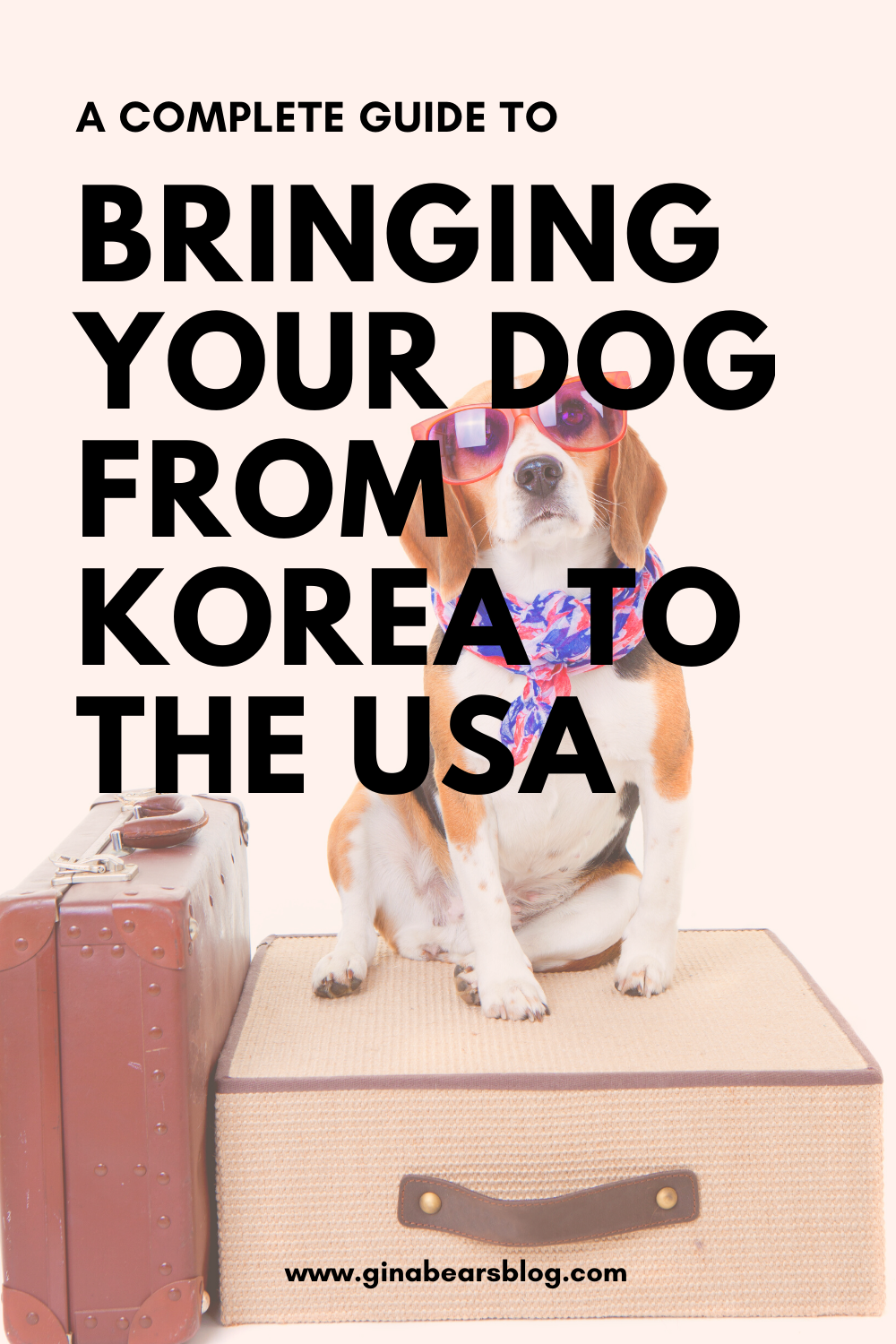
This post contains affiliate links which means at no additional cost to you, I make a small commission to help keep Gina Bear’s Blog running. Thanks for your support!

Free Seoul E-Book
Do you love South Korea?
Enter your name and email address and click the button below to receive your Easy Seoul Travel Guide so you can travel like a local!








This was super helpful for me! Thanks Gina!
I am looking to bring my cat from Korea to Atlanta, GA. I am so stressed making sure I have all of the correct documentation. Do you have any information about the necessary documentation? Did you travel with a dog or cat? Is it the same?
Hi Sidney! I would like to hear more about your experience in bringing your cat from korea, is it okay to connect through instagram/kakao/email? I will travel with my cat to my home country in the following months, it would be helpful to hear from the experienced one! Thanks 🙂
Thanks Gina! You did a fabulously comprehensive write up of the factors to consider. Really helpful : )
With the new 2021 regulations, I’m reading mixed messages about the microchip. Do dogs have to be microchip’d in order to enter the US?
Also, do you happen to have any info on what I would need to prepare when returning to Korea with a dog?
Thanks in advance!
A very useful and helpful piece! Thank you for doing this as I’m thinking of taking our pup to the US for holiday.
Hello! Do you need an appointment for the Animal Plant and Quarantine Agency?
Hello
I’m confused because the cdc step 1 says if your dog has not been in a high risk country rabies vaccination is not required but then on step 5 seems that rabies vaccination is required? Anybody have any clarification?
I’m bringing my cat to South Korea from LA in October. She already had her microchip and rabies vaccine. We are going to have FAVN in a month. We will just be in Korea for 12 days. Do we still need to see a vet in Korea? Thanks